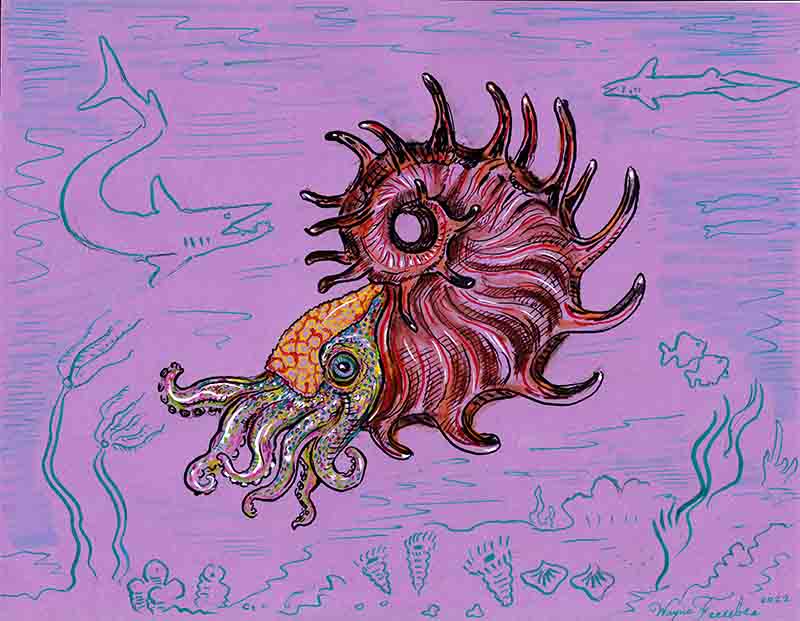You are currently browsing the tag archive for the ‘merman’ tag.

Last week I finished up the AtlasObscura course on cephalopods, a Zoom mini-survey of this astonishing class of mollusks. The course was a delightful romp through morphology, taxonomy, paleontology, and ecology and featured some virtuous side lessons about how to protect Earth’s ecosphere (and ourselves).
The incredible diversity, beauty, and wonder of cephalopods reminded me that I have not blogged about them…or any molluscs…or anything else for far too long. Ergo, as a promise of more posts to come, here are two little cephalopod drawings I made to share with the class.
The first picture (top) is an Indo-Pacific cuttlefish enjoying the reef and trying to overlook the whimsical Thai/Malay merman who has appeared out of the realm of fantasy (note also the reef shark, giant clam, and mantis shrimp). The second image (as per “homework” instructions) is a cooperoceras flashing iridophores which it may or may not have had as various lower Permian sea creatures (most notably Helicoprian) look on in dazzled envy.

We will talk more about these creatures in weeks to come (and maybe more about the Permian too, since I keep thinking about how the Paleozoic ended), but for now just enjoy the little tentacled faces! Also, it is “inktober” and I have been obsessed with classic pen and ink, so maybe get ready for more drawings as well (to say nothing of our traditional Halloween theme week, which will be coming up quite soon).
In the Northern hemisphere today is the summer solstice—the longest day of the year. Here in Brooklyn, the Saturday closest to the solstice (which, this year, happens to also be the solstice) is the occasion of the Mermaid Parade, a great festival to Neptune, the Roman god of the ocean. Revelers gather in Coney Island which is a famous beach by the Atlantic Ocean. Artists, mummers, and lovers of the ocean dress as sea creatures, mermaids, and oceanic beings and parade down Surf Avenue before proceeding through Luna Park and to the beach. As a Brooklynite, I thought I should likewise celebrate Neptune and the glorious beginning of summer—which I am doing by showing one of my paintings. The title of this work is “King Cake” and everything you see is some sort of king. There is King Neptune, a king salmon, the king of herring, a king vulture, and a princely crown. The colorful torus-shaped cake is known as a king cake, which is eaten down south during carnival season. When the cake is consumed, the person who receives the piece with the baby baked inside is given a golden coin…or maybe sacrificed to the ancient gods (depending on one’s denomination and traditions). Carnival and Mardi Gras are not celebrated in Brooklyn: instead we have the mermaid parade on the summer solstice! Hail Poseidon! Hail summer!
This week Ferrebeekeeper has been all about Tritons: we published posts on 1) The retrograde ice moon of Neptune; 2) the giant starfish-eating gastropod; and 3) the Greek merman god. The only major definition of triton left is the nucleus of a tritium atom which has one proton and two neutrons (as opposed to a normal hydrogen atom which has one proton and NO neutrons). Tritium is very important in nuclear engineering and could be critical to the development of nuclear fusion reactors—an effort which I regard as being of paramount importance to getting humankind moving forward. Unfortunately, I am no nuclear engineer, so you will have to research tritium elsewhere.
What I did discover is that, for some reason, Triton is incredibly popular as a mascot. Numerous semi-professional and school teams have a triton (a merman) as a mascot. Is it because the figure is solemn and powerful? Is this a last breath of Greek polytheism blowing through America’s high schools and colleges? Do people simply love mermen? I have no idea, but for a lighthearted Friday post, here is a gallery of Triton mascots.
Enjoy the mermen, stay warm, and I’ll see you next week!
Triton (the moon) and tritons (the gastropods) are named after…Triton, a Greek sea god who was the son of Poseidon (king of the sea) and his wife Amphitrite (herself a daughter of the ocean titans Nereus and Doris). Triton was portrayed as a mighty merman who carries a musical conch with which he calms the seas…or whips them into a frenzy.
Triton lived with his parents in a golden palace beneath the waves (according to Hesiod). He has a few cameo appearances in classical mythology (most notably in the story of Jason and the Argonauts) but he is generally overshadowed by his mighty father. In late antiquity and the Renaissance, Triton came to be a sort of progenitor of mermaids and mermen (a role which he occupies in Disney’s “animated film The Little Mermaid”).
Geologists know that oceans and seas are indeed ever-changing and protean. Whenever I think of Triton, I imagine how the oceans of the world will be entirely different in a few hundred million years (just as today’s oceans are no longer the Tethys or the Panthalassic Ocean). Neptune’s reign will end and the oceans and seas will change–and yet they will really be the same great world-sea as they have been since the beginning.
















